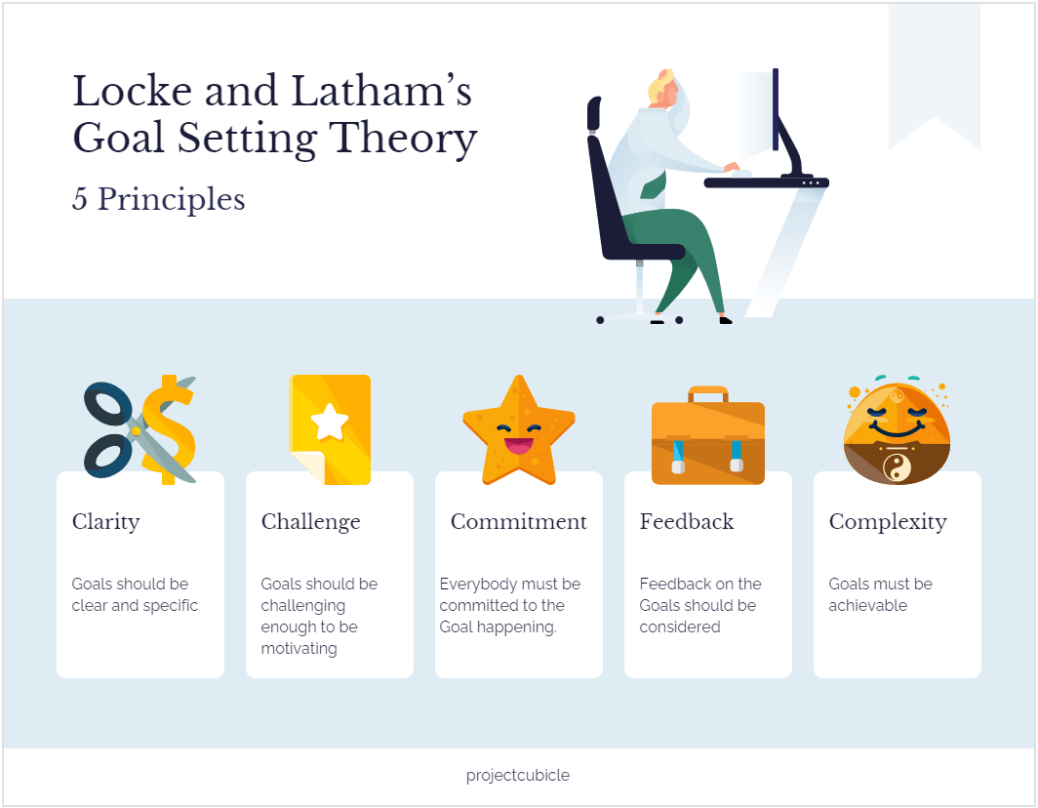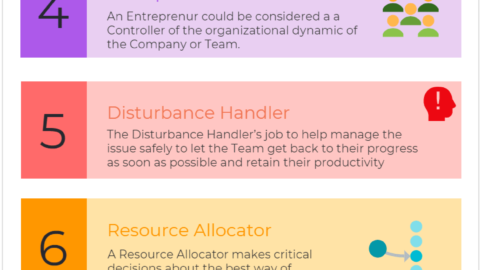Locke and Latham’s Goal Setting Theory
What is Goal Setting? Why is Goal Setting important? What are the 5 principles of Locke and Latham’s Goal Setting Theory? How do you achieve Improved Success and Higher Motivation by using Locke and Latham’s Goal Setting Theory? How do you motivate Your Team towards overcoming complex tasks?
Table of Contents
You have to set goals that are Almost Out Of Reach. If you set a Goal that is Attainable Without Much Work or Thought, you are stuck with something BELOW Your True Talent and Potential.
Steve Garvey
Dear Reader, welcome to another article about another exciting subject, only here at Project Cubicle. As Team Cubicle, we hope you are utilising and applying the knowledge we share with you in our articles to your daily and business lives, meanwhile achieving gigantic self-growth.
In our articles, we aim to bring you hundreds of techniques that are applied in both business and daily fields to help achieve continous improvement, self-realization, personal and organizational growth, that will step by step lead you towards Success.
Today, we are going to share one of the most critical factors of being successful, that is Setting The Right Goal, before even beginning to make any effort.
And with that, let us linger no more and dive right in.
Locke and Latham’s Goal Setting Theory
WHY DOES SETTING THE RIGHT GOAL MATTER?
In our previous articles, we have discussed the importance of having a Road Map in our hands before we even begin our passage.
It is crucial and vital to know:
Where are we going and Why?
What will that journey let us unveil or acquire?
What will we gain out of that experience? What do we intend to gain?
In other words,
What is Our Objective in moving towards This Destination and Not the Other?
And one more thing:
Is Our Objective Motivating Enough to Keep Us On The Way?
And that is what Locke and Latham realised and were inspired to create the infamous, Locke and Latham’s Goal Setting Theory. They saw 5 different characteristics to help aiming Better Goals, and therefore IMPROVED SUCCESS.
5 Principles of Locke and Latham’s Goal Setting Theory
These Characteristics were:
- Clarity
- Challenge
- Commitment
- Feedback
And…
- Complexity
We will discover the reason why we have separated the 5th Principle of Locke and Latham’s Goal Setting Theory below.
Long Term Goal Achievement Provides Higher Motivation.
One more time.
Long Term Goal Achievement Provides Higher Motivation.
This phrase is a bit general, isn’t it?
Who does long term goal achievement provide higher motivation?
Where and when does this process take place?
What is the achievement?
And what Locke and Latham realized was exactly this.
1. Clarity
In order for a Goal to be understood by not just the employees or Team Members, and instead anyone, it should be specific and simple.
ALWAYS HAVE CLEAR AND SPECIFIC BUSINESS OBJECTIVES BY LISTING SPECIFICALLY WHAT TO DO UNTIL WHEN.
Example:
“Increase the weekly profit in Market A by 4% from 3% in 4 weeks.”
Now the employee or the person knows exactly what to do and until when.
What motivates the employee towards achieving this goal?
The Employee has to figure out the means to do so, meaning its “How?”.
How will they increase the weekly profit in Market A by 4% from 3% in 4 weeks?
And the Brainstorming begins.
At this moment, what intrigues the employee is the Challenge. And Challenge is the 2nd Principle of Locke and Latham’s Goal Setting Theory.
2. Challenge
If the goal had been to “increase the weekly profit in Market A, B, and C by 10% from 3% in 4 weeks”, it would intimidate the Employee. The Employee would be anxious as in not to fail, however still would have insecurities about the given task and not being able to make it in the given time. That goal would have been over-challenging.
The secret is keeping the challenge at the right amount. The Employees need to know that their goal is valuable and not just random, their goals should also give the feeling of “(it was difficult but..) I made it!”
You are familiar with that feeling: The Sweet Taste of Success should not cost a handful amount of Pain.
Although still, the goal should be worth of wanting to see the results, in other words achieving it. Easy goals may not create enough motivation and result in decreasing the drive of Team’s Momentum.
LIMITED, SPECIFIC, & CHALLENGING GOALS = MORE SUCCESS
3. Commitment
Why should the Employees stay committed to that specific goal? If they do not individually accept and believe in the worth of the goal, they will not do their best to achieve it. For an instance some individuals are more motivated when they are given the exact list of tasks that inform them about what they should do, however if the employee is motivated by having more space to put themselves in, they might be more eager to achieve the goal if they can define the goal themselves.
Because they embrace the task so innately, they get more committed and in conclusion more motivated to achieve the goal themselves.
In summary:
Commitment + Their Commitment = Increased Motivation
And this is achieved by either the manager assigning the goal with a rationale, or setting the goals in collaboration with the Team Members so that a dictatorship does not occur.
4. Feedback
Constructive, measurable, filled with utilisable information and accurate Feedback is vital at all times. The employee should know. Yes, they are giving their best and working on that task hours after hours but what is their best equal to?
Is their best objectively what the task needs from them to do? Are they wasting too much time on something they should not do? Are they on the right track and direction? What could they do better and how could they do that better in order to achieve Improved Success and Growth?
And the 4th Principle of Locke and Latham’s Goal Setting Theory is exclusively highlighted by the theoricians themselves, in order to Improve Performance and acquire Higher Motivation.
Lastly, the 5th Principle of Locke and Latham’s Goal Setting Theory: Complexity.
5. Complexity
As we discussed in the 2nd Principle of Locke and Latham’s Goal Setting Theory, Challenge, the Goal should be the right amount of challenging and now advancing it further, the determined Goal has to be complex but divisible into small-size parts, or chunks.
For an instance, if you say “design a product that will increase our efficiency by 25%”, the employee might feel terrorized.
But again, the Goal should be both understandably Crystal Clear and Complex enough to break down into parts and work on each part at different times.
For an instance, let’s assume the product here is a website. Creating a website that will decrease their costs by 25% to be precise. Now if this efficiency will be obtained through some modifications in the backend of the website, the number one challenge of the Team Member will be to find a qualified Backend Developer. Meanwhile, if User Experience has also an important part in increasing the efficiency (i.e., some operations are functioning not simple enough), the Employee will need a proficient Frontend Developer to develop the interface of the website.
Now that is 2. But what will the website include as an information? What will be the message? What does the Brand Manager have to say about Branding on the website? How will the company present themselves? Will the site feel natural, elegant, or chill?
What if the goal has been to gather information about Branding of the Organization in order to include in the website? Would it not be too simple or easily doable? Would the employee feel motivated or feel that there is a reward at the end of achieving that goal?
Complexity is about breaking the tasks down to sub-goals in a way that the Employee does not feel that the goal is unachieveable or that they lack the skills to accomplish that goal.
If the employee currently does not have the necessary skills (i.e., there is a new CRM software and due to increased efficiency in direct operations, the organization decided to make a switch, and the employees naturally do not have any knowledge of using it), Training, Workshops, Webinars and more should be provided to the employee so that they can succesfully carry out the task they were given.
How do you achieve Improved Success and Higher Motivation by using Locke and Latham’s Goal Setting Theory?
Let’s review what we’ve covered in this article about Locke and Latham’s Goal Setting Theory:
We have once again emphasised the importance of having a clear Goal, easily understandable by anyone the Goal is communicated to. Then we discovered that Clarity was not it and if the Goal was not challenging enough, the Employee or the Team Member would not be motivated enough to achieve it! Moreover, we examined that if an Employee has a chance to have a say in the Goals that are appointed to them, they are more likely to commit and therefore show a higher performance working to achieve them! Furthermore, we saw how getting constructive and informative feedback is helpful to the employee assuring themselves that they are on the right track! And finally we saw that it was not enough for the Goal to only be Challenging to motivate the employee towards enacting it but also the level of complexity! We realized that if the appointed Goal was too easy, the employee may feel demotivated or incapable, or even feeling that they are lacking the necessary skills to earn a more complex one, a more complex Goal.
Ultimately, we learned that Goal Setting is not simple as it sounds and it takes more effort to succesfully set the right goal for the right person for that Goal to be masterfully achieved!
And that is all we have to say for now about Locke and Latham’s Goal Setting Theory, here at Project Cubicle.
Do you agree with Locke and Latham?
If you had a make an addition to the theory, what would it be?
What do you think is the most critical factor when it comes to Goal Setting?
Is there a content or another exciting theory you’d like us to cover here at Project Cubicle?
Cubicle Team loves reading your comments!
So please let us know more in the comments section below!
See Also
Further Reading
Building a practically useful theory of goal setting and task motivation










